Duke grapes: all about cultivating the variety
The Duke hybrid grape belongs to the new varieties. Like any novelty, it is of interest to gardeners. So far, the reviews about the variety are somewhat contradictory. Experts note that it requires study and observation. But some conclusions can already be drawn.
Content:
Description of the variety
Herzog grapes were bred by amateur breeder A.V. Burdakov. This is not the first variety in his collection. The author created a hybrid Duke, crossing the Talisman varieties with Hadji Murat. The result is an early ripe hybrid with a period from flowering to fruit ripening of 3 months.
It got its name for large clusters, the weight of which ranges from 0.5 kg to 1.1 kg.
According to the description, they consist of large oval-shaped berries of dark purple color. Weight of one from 15 g. Fruits are covered with a blue waxy bloom. Reviews of some growers claim that their bush does not form bunches. Only single, very large berries grow. Perhaps this is due to insufficient care.
The berries of the Duke variety are delicious, the flesh is fleshy, and at the same time juicy. It is covered with a rather dense skin. It does not allow the fruit to crack when ripe, but is practically invisible when eaten. The Herzog grape bush is tall, grows quickly, building up powerful shoots. They ripen well. The flowers are bisexual, so the variety does not need pollinators to be placed nearby.
Reproduction
The Duke Hybrid cannot be grown from seed. Usually buy ready-made seedlings with strong root system, open or closed. But amateurs often propagate grapes from cuttings. Less commonly used vaccination.
Features and rules for grafting:
- Cuttings with 2-3 buds are cut from autumn. The length of each is about 15 cm. They are stored in a cellar by immersing the ends in the sand. It should be kept moist all the time, but not wet.
- In February, you can start germinating cuttings. They are taken out of the cellar, washed in running water, and dried. Cut with a sharp pruner: from above at a distance of 2 cm from the upper kidney, from below by 1 cm from the lower one. With a knife or the same pruner, several cuts are made in the lower part of the cutting. It is in this place that callus will grow, and then roots will form.
- The cuttings are soaked for a day or two in clean water. Then it is treated with a solution of a root former, for example, heteroauxin.
- They start kilchevaniya - germination of cuttings at different temperatures of the heel of the cuttings and upper buds. The lower part is kept at 20-25 ° С, the upper part - at 15 ° С. If this procedure is not done, then a sprout will quickly develop from the upper bud, and the root system will lag behind. Kilchevanie is carried out for about 2 weeks.
At this time, a mixture is prepared for planting cuttings. Mix sand, rotted sawdust, humus, peat. Such a mixture will not thicken and rot, so the cuttings will not disappear in it. Moisten the prepared soil and pour it to a height of 7 cm into the prepared dishes. Most often these are 1.5 liter polyethylene bottles with a cut-off top and large holes in the bottom for water drainage.
A stalk with callus or small roots formed during kilchevanie is placed on the soil layer. The remaining space is filled up, compacting the substrate. The upper kidney remains open. An escape will grow from it. To prevent it from drying out, cover it with a plastic cup.Kidneys that go underground are not needed. Therefore, they are cut off.
Periodically water the soil in a bottle, make sure that it does not dry out. The roots that appear after a while can be seen through the plastic of the bottle. This is another advantage of such cookware.
Landing
They are in no hurry to plant a rooted stalk. It is better to do this at the end of May on a cloudy day, so that the bright rays of the sun do not burn the young leaves. But first, for at least a week, the cuttings are hardened by setting them in the fresh air.
Landing technology:
- Choose a place for planting grapes. It can grow on almost any soil except waterlogged. It is good if there is an opportunity to land on the southeastern or southern slope, in a sunny and open area. Duke grapes can be planted near buildings or fences, creating arches and gazebos from it. But the distance from the bush to the building should be about 1.5 m. If planted very close, the water from the roof can flood the roots, leading to decay. When planting several bushes of grapes, the distance between them should be about 3 m.
- Dig a pit for grapes 50 cm wide and 60 cm deep in advance. It is better if it is prepared for spring planting in the fall. The top layer of earth is laid on the side. Stir with humus, superphosphate, add a jar wood ash.
- The resulting mixture is poured into the bottom of the pit, forming a mound. A seedling taken out of the bottle is installed on it. In order not to damage the roots, it can be cut from the side.
If the soil has crumbled, spread the roots along the sides of the mound. Sprinkle with prepared soil. After filling half of the pit, pour a bucket of water. Make sure that the seedling does not go to the bottom of the pit. To do this, hold it with your hand. A peg-support is installed, to which the bush will subsequently be tied. They fill up the earth, using the one that was previously set aside.
If the seedling has a developed above-ground green part, then the soil is covered up to the base of the shoot.
If cuttings are planted in which the upper bud is not developed, a mound of earth is poured above it. Do not seal. The sprout that forms from the bud should easily come out. Shade from the sun. If the soil has not fallen away from the roots or when planting a cutting with a closed root system, a layer of earth 5 cm high is poured onto the bottom of the pit, a lump of earth with a cutting is placed, a peg for tying is placed next to it, and the hole is filled up.
When planting annual seedlings, first root the heel roots to a length of up to 10 cm, remove the dew roots. Leave the two strongest shoots, shortening them above the second eye. If there is only one shoot, 3 buds are left. Dip the roots of the Duke grapes in a clay chatterbox. In the northern regions, where the Duke grape bushes are prone to freezing, it is advisable to plant them in trenches, deepening below ground level. In this case, the heel roots of the grapes will be less damaged by frost.
Care
The Duke grape bush is formed from two sleeves. For this, in the first year after planting, the two strongest shoots are grown. Additional branches, stepchildren, which usually form on the bush, are removed, not allowing them to use nutrients.
If the bush was formed from one vine, choose the strongest stepson who looks in the opposite direction, the rest are removed. A second sleeve will form from it. In the first year, the vine should grow to a height of one and a half meters. At the beginning of September, they stop watering the bush, pinch the upper part of the shoot. This procedure will help ripen the vine.
Helpful Care Tips:
- In spring, Duke grapes need a lot of moisture. If the soil is dry, watered before bud break. Do not water the grapes during flowering or in front of it. If this is done, a large number of flowers will fall off. A large amount of moisture must be added immediately after flowering. Following watering carried out during the period of pouring berries and staining them purple. Before harvesting, do not water so that the skin of the grapes does not crack.You need to add water infrequently, but in large quantities, so that the soil is well saturated with moisture. After watering, the soil is loosened in the aisles. A large amount of moisture is just as detrimental to the crop as its lack. If the soil is too wet, then there will be a lot of stepchildren on the bush, the berries will ripen later, the vine will not ripen well. If autumn is dry, water-charging is carried out.
- Be sure to carry out the formation of a bush. It is cut into 6-8 buds. As a result, no more than 30 buds should remain on the bush. Pruning held in the fall. If you do this in the spring, the bush will "cry", that is, lose juice. In the summer, they regularly break off stepchildren and shorten green shoots.
- The Duke grape definitely needs support. Without it, he will not produce the harvest that can be counted on.
- The Herzog variety has an average resistance to the main diseases of the grapes with mildew and powdery mildew. Therefore, it is necessary to carry out the prevention of these diseases by treating with copper-containing preparations: in early spring with Bordeaux liquid, during the growing season Skorom.
- The Duke variety should not be left without shelter for the winter. Indeed, according to the author, it can withstand temperatures down to 23 ° C. The young Duke grape bush is especially afraid of frost. In the fall, the vines are cut into 4 buds, laid on the ground. They are fixed to the ground, covered with light soil. The peg is not removed so as not to lose its location. In the spring, do not forget to remove the shelter so that the kidneys do not snot.
Adult bushes are also covered for the winter. After the leaves fall off, pruning is carried out, the lashes are tied with twine, laid on the ground or in a specially prepared ditch. Sprinkle with earth or covering materials. The dangers that lie in wait for the bush in winter: damping of the buds during a thaw and the eating of the buds and bark by rodents. Therefore, you should not cover the bush with straw, and in regions with warm winters - with polyethylene.
More information can be found in the video:



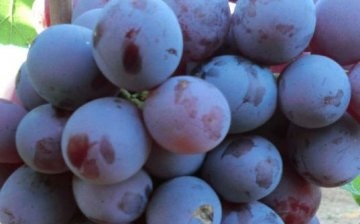
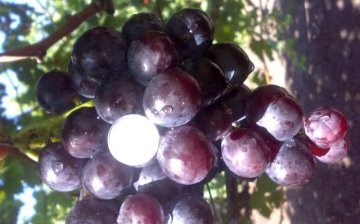
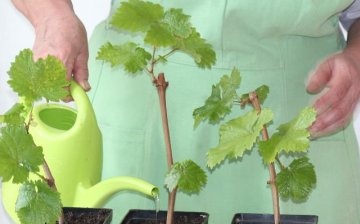
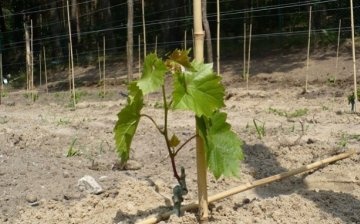
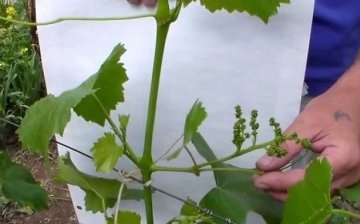





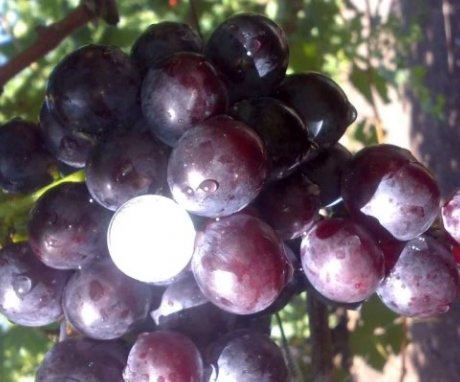
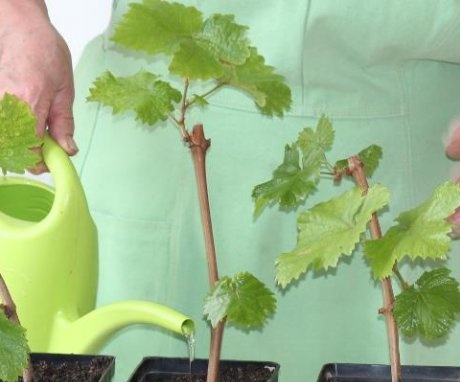

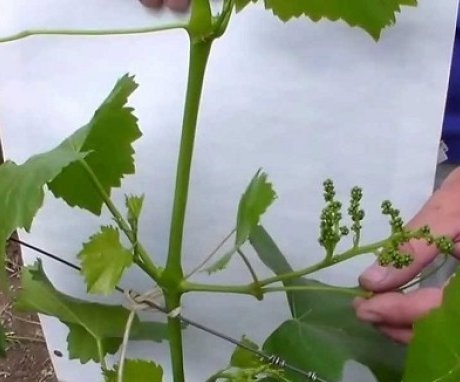
In our region, I have not yet come across such a variety. According to the description, the variety is very interesting, however, it is not clear why the Duke requires multiple watering? We do not need to cover this variety for the winter, since frosts are more than 23 degrees, they are rare and, moreover, not every winter.